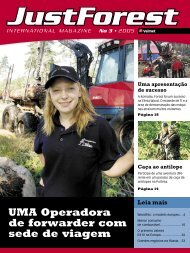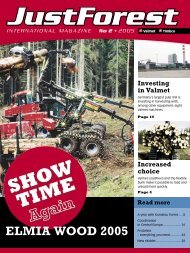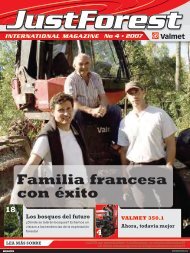English - Komatsu Forest
English - Komatsu Forest
English - Komatsu Forest
Create successful ePaper yourself
Turn your PDF publications into a flip-book with our unique Google optimized e-Paper software.
There’s a great deal of combustible material in the forests of<br />
America, with as much as 50 tons of biomass per acre (120 tons<br />
per hectare).<br />
pine beetle infestation is the reason<br />
in Canada. Thinning damaged<br />
trees and rapidly removing<br />
infested timber is important<br />
in the fight to stop the beetle’s<br />
spread.<br />
THINNING IS EVEN increasing<br />
in Europe, though mostly due to<br />
increased demand for biomass<br />
fuel and new harvesting methods<br />
are on the horizon. Antti<br />
Asikainen, a professor at Finnish<br />
forestry research institute Metla,<br />
believes interest in small diameter<br />
timber harvested using multi-tree<br />
accumulators, as well as<br />
the clearing of older stands, will<br />
increase. Asikainen has a theory<br />
as to why the demand for biomass<br />
fuel has not been the driving<br />
force in North America.<br />
“North America, and even<br />
Russia, have much forest and get<br />
as much bioenergy as they need<br />
from sawmills without the need<br />
to specifically harvest the forest<br />
for biomass fuel,” he explains.<br />
Don Gosnell at the Ministry<br />
of <strong>Forest</strong> and Range in British<br />
Columbia, Canada confirms<br />
this idea and explains that most<br />
sawmills use the waste from<br />
sawing, such as sawdust, wood<br />
28 JUST FOREST NO 4 • 2007<br />
chips, and even bark, to produce<br />
heat and electricity as the material<br />
needs to be dealt with in some<br />
way or other. However, according<br />
to Gosnell, electricity is so<br />
cheap (about 3.5 cents per kilowatt<br />
hour) that it’s unprofitable<br />
to produce electricity from waste<br />
if it has to be transported to the<br />
generating facility.<br />
Asikainen, on the other<br />
hand, sees development gathering<br />
momentum in Europe, with<br />
more and more countries in Central<br />
Europe, including Italy and<br />
Austria, and even Poland, harvesting<br />
round timber and forest<br />
residues simultaneously. Wood<br />
chips are generally produced at<br />
landings, before transportation.<br />
Asikainen also sees greater interest<br />
in Europe for stumps, which<br />
have greater energy value than<br />
other forest residues.<br />
ROLF BJÖRHEDEN heads a biomass<br />
fuel project at Swedish<br />
research institute Skogforsk and<br />
believes development must be<br />
toward increased optimization<br />
and increased integration of biomass<br />
fuel management with<br />
other forestry. Björheden believes<br />
biomass harvesting will be<br />
Canada produces enormous amounts of sawmill waste. So much<br />
that it’s currently unprofitable to harvest biomass from the forests.<br />
New assortments will be handled by existing machines parallel to<br />
conventional harvesting.<br />
integrated with other harvesting<br />
using existing machines, a<br />
matter on which Asikainen also<br />
agrees, adding that conventional<br />
forest machines, with necessary<br />
adaptations for handling biomass,<br />
are the route to take for the<br />
foreseeable future. r






